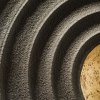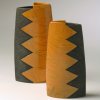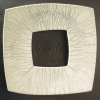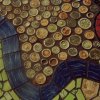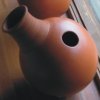Udus
The udu is a percussion instrument originally from the Nigeria. Traditionally the udu was a water carrying vessel with additional hole in the side, played by women for ceremonial music. It is usually played while sitting cross-legged with the udu placed at an angle comfortably in the lap.
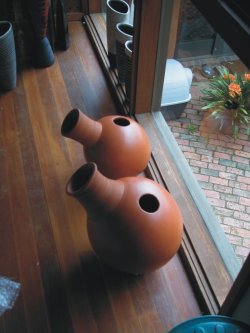
There a range of sounds possible from this instrument, tapping the body makes a dry pitter-patter sound. a quick palming of the side hole produces a rising gloop sound. The third type of sound is produced by palming the hole and briefly holding the hand still. The player can feel the sound wave reverberate back onto the hand form inside the body of the instrument. This third action gives a deep booming bong sound especially with the larger bodied udus. The pitch of the notes can be raised somewhat by partially covering the neck opening while the side hole is struck.
Rather surprisingly in this technological age the udu has become a very popular instrument for the contemporary percussionist, and can be identified quite often when you know what to listen for, offering an intriguing percussive base note and rhythmic patter.
Traditionally udus were hand made using local clays and fired to a low temperature probably in a pit or above ground on a pyre -the porous, lower fired ceramic gives a more velvety tone than the higher fired cousins made by some contemporary makers. There are even some udus made of plastic which have their own unique voice.
These udus were made from terracotta clay using the potters wheel. When partially dry (leather hard), I burnished them to give a sheen to the body. I then fired them to 800°C in a gas fired kiln. The earliest udus, being water carriers, often had chord wound around the neck for better grip and some had chord handles attached. I have introduced the linear decoration on the neck to echo this piece of their history.
